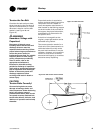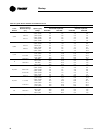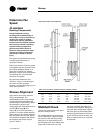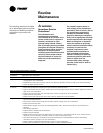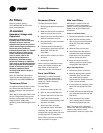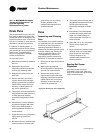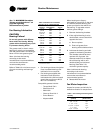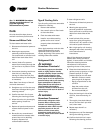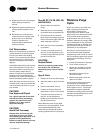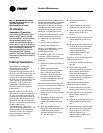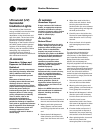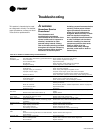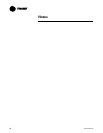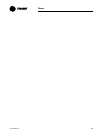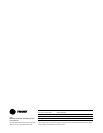
Routine Maintenance
54 CAH-SVX01A-EN
See “
ƽ
WARNING Hazardous
Voltage with Capacitors!” on
page 49 regarding
disconnection of power.
ƽ WARNING
Hazardous Chemicals!
Coil cleaning agents can be either
acidic or highly alkaline. Handle
chemical carefully. Proper handling
should include goggles or face
shield, chemical resistant gloves,
boots, apron or suit as required. For
personal safety refer to the cleaning
agent manufacturer’s Materials
Safety Data Sheet and follow all
recommended safe handling
practices. Failure to follow all safety
instructions could result in death or
serious injury.
Internal Insulation
The process of cooling and
dehumidification produces
condensate that must be
continuously removed from the air-
handling unit. The section of the unit
from the entering air side of the
cooling coil to the leaving edge of
the drain pan is considered to be the
“wet” section of the unit. Other
potentially “wet” sections are
immediately downstream of a
humidifier and/or an outside air
intake section.
Internal insulation in areas of the
unit that are normally considered to
be “dry” must also be periodically
inspected to assure the insulation is
clean and dry. Wet insulation in an
area that is normally considered to
be “dry” can indicate an operational
problem (refer to the
“Troubleshooting” section on
page 56 for further information). The
equipment should be inspected a
minimum of every six months or
more frequently as operating
experience dictates.
Accumulated dirt and other organic
matter exposed to water or extended
periods of high relative humidity
(60 percent or higher) can support
microbial growth, which must be
removed to prevent the unit from
becoming a contaminant source.
If evidence of contamination exists
in either the wet or dry sections:
• Determine and eliminate the
cause.
• Remove the contamination.
• Sanitize the affected area.
See the “Troubleshooting” section
on page 56 for assistance in
identifying the cause.
If microbial growth on a non-porous
insulating surface (closed cell
insulation or sheet metal surface) is
observed:
1 Disconnect all electrical power to
the unit.
2 Wearing the appropriate
personal protective equipment,
use a brush for sheet metal
surfaces or a soft sponge on a
foil face or closed cell foam
surface to mechanically remove
the microbial growth.
Note: Be careful not to damage the
non-porous surface of the insulation.
3 Install a block-off to prevent
spray from going into a dry
section of the unit and/or system
ductwork.
4 Thoroughly clean all areas with
an EPA-approved sanitizer
specifically designed for HVAC
use.
5 Rinse the affected surfaces
thoroughly with fresh water and
a fresh sponge to prevent
potential corrosion of the drain
pan and drain line.
6 Repeat steps 4 and 5 as
necessary.
7 Confirm the drain line is open
following the cleaning process.
8 Allow the unit to dry thoroughly
before putting it back into
service.
9 Replace all panels and parts and
restore electrical power to the
unit.
10 Be careful that any contaminated
material does not contact other
areas of the unit or building.
Properly dispose of all
contaminated materials and
cleaning solution.
To clean a porous insulating surface
(fiberglass insulation):
1 Disconnect all electrical power to
the unit.
2 Wearing the appropriate
personal protective equipment,
use a vacuum device with a
HEPA filter (99.97 percent
efficient at 0.3 micron particles)
to remove the accumulated dirt
and organic matter.
Note: Be careful not to tear the
insulation surface or edges.
3 Confirm the drain line is open
following the cleaning process.
4 Allow the unit to dry thoroughly
before putting it back into
service.
5 Replace all panels and parts and
restore electrical power to the
unit.
6
Be careful that any contaminated
material does not contact other
areas of the unit or building.
Properly dispose of all
contaminated materials and
cleaning solution.



